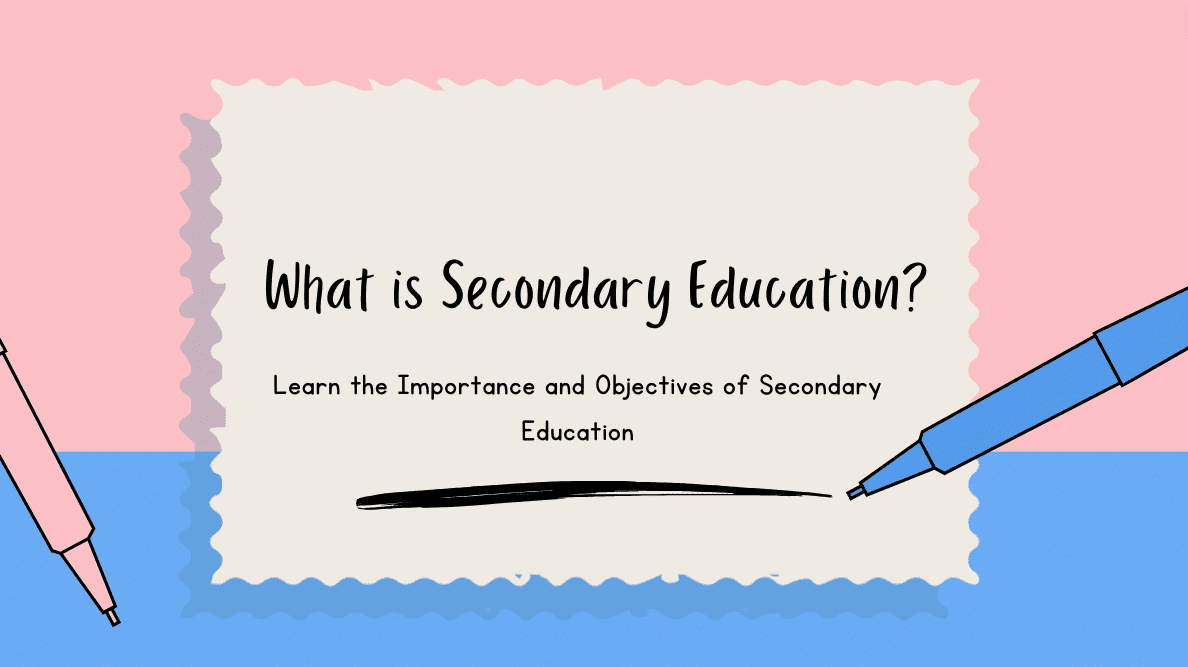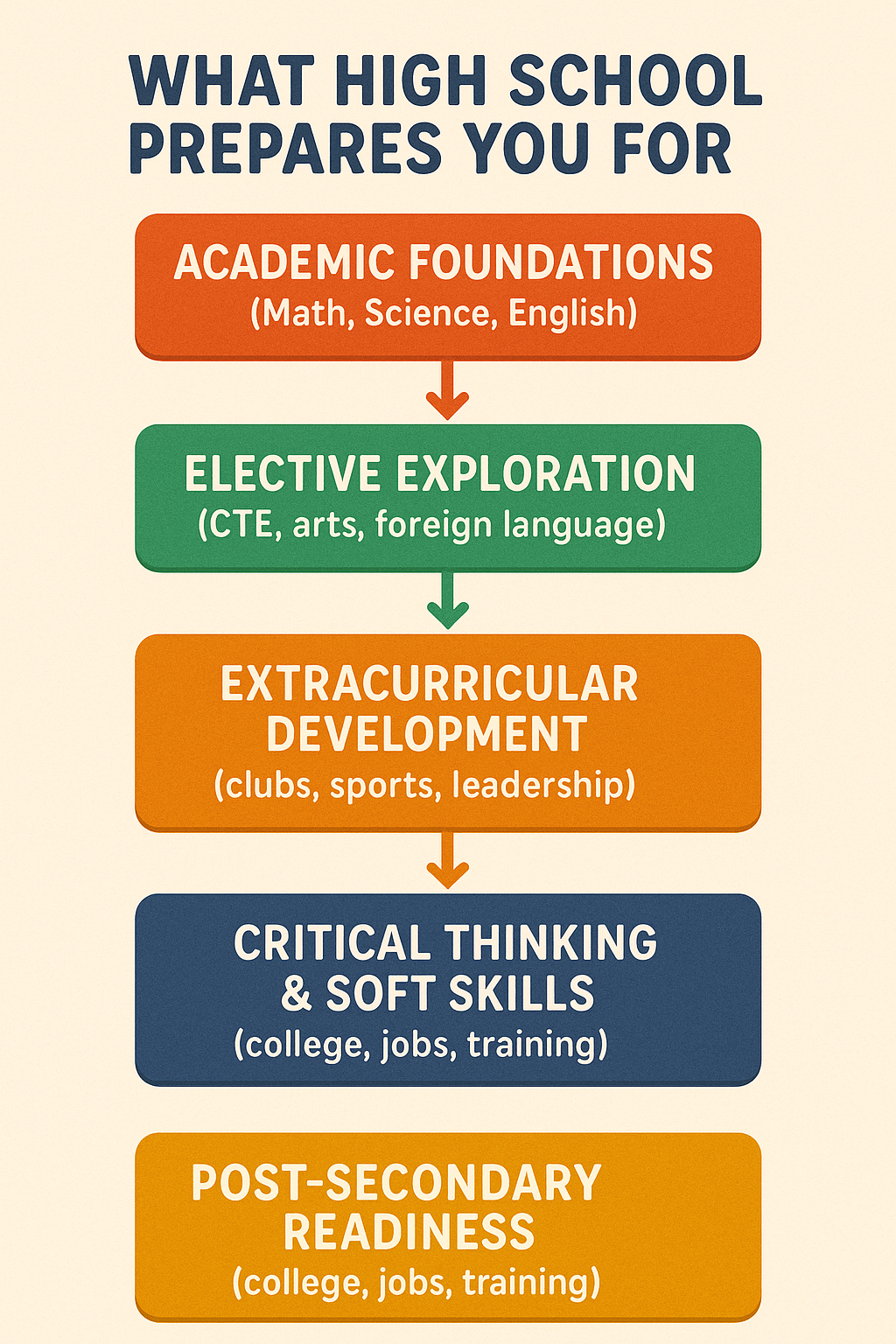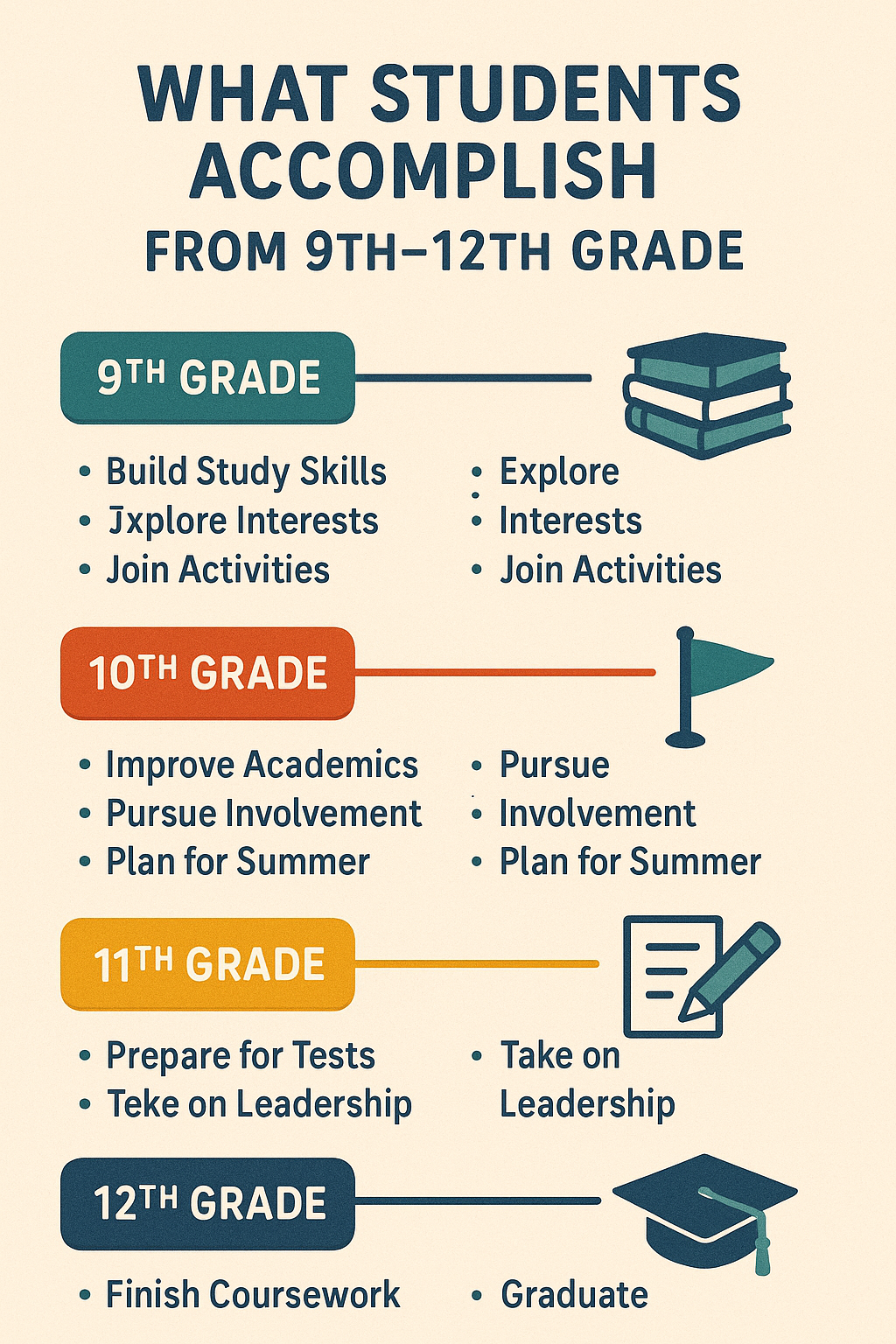
What Does Secondary Education Mean?
“Wondering where ‘secondary school’ fits in the American education system? Whether you're a student, parent, or international reader, this guide breaks it down clearly—backed by real-world insight and U.S. education standards.”
Quick Definition
Secondary education refers to the formal stage of learning that follows primary school and prepares students—typically aged 12 to 18—for college, careers, and civic life. In the U.S., it usually includes grades 6–12 (middle and high school). But it’s more than just a bridge: secondary education is where students explore academic depth, build real-world skills, and start shaping their personal and professional identities. It’s the launchpad for lifelong learning and informed decision-making in an increasingly complex world.
Why It Matters in the U.S. Context
In the U.S., the education system follows a K–12 model:
| Stage | Typical Grades | Age Range |
|---|---|---|
| Primary School | K–5 | 5–11 years old |
| Secondary School | 6–12 | 12–18 years old |
| Postsecondary | College/Uni | 18+ |
Secondary education is more than just a bridge between childhood and adulthood—it's the foundation where students begin to specialize academically, explore their interests, and develop critical thinking and career readiness.
◆“In high school, I discovered my passion for environmental science—and that led to a full scholarship in college. That’s the true power of secondary education.”
Key Components of U.S. Secondary Education
Middle School (Grades 6–8)
- Focuses on transitioning from basic literacy/numeracy to subject-based learning
- Subjects include science, social studies, mathematics, language arts, and physical education
- Emphasis on soft skills: collaboration, responsibility, digital literacy
Related:
What does product mean in math?
High School (Grades 9–12)
Often called "senior high school" or simply "high school"
Students earn credits toward graduation through core and elective courses
Curriculum typically includes:
- English (4 years)
- Math (3–4 years)
- Science (3 years)
- Social Studies (3 years)
→ Foreign Language, Arts, Physical Education, and Electives
→ Standardized tests (e.g., SAT, ACT) are commonly taken in 11th or 12th grade
→ Prepares students for college, trade schools, military, or workforce entry
| Path After Secondary School | Description |
|---|---|
| Postsecondary Education | College, university, trade/vocational |
| Military Service | Enlistment post-high school graduation |
| Immediate Workforce Entry | Job readiness with diploma or training |
| Gap Year / International Exchange | Optional experiential year |
Related:
What Will You Do To Maximize On Your Postsecondary Education Investment?
Related Terms & Clarifications
- “High School” = Secondary School (in U.S. terminology)
- “Post-Primary” = Any schooling after elementary/primary
- “Postsecondary” = College, university, or vocational training
- “K–12” = Kindergarten through 12th grade (entire pre-college journey)
- “Secondary Education Degree” = A college degree for future high school teachers (often confused with the term itself)

Defining Secondary Education in the United States
In the U.S. educational system, secondary education refers to the stage of schooling that follows primary (elementary) education and precedes post-secondary or tertiary education. It typically includes high school (grades 9–12), but in some district models—especially junior high systems—grades 6–8 are also considered part of secondary education. The primary purpose of this stage is to equip students with academic knowledge, social skills, and personal discipline necessary for college, vocational training, or the workforce.
Secondary education is mandatory in all U.S. states up to a certain age (usually 16 or 18), and it culminates in the awarding of a high school diploma, which serves as the minimum credential for most forms of employment or further education.
What Grades Are Considered Secondary Education?
In most U.S. school districts, secondary education is divided into:
High School (Grades 9–12) — The Standard Model
This is the most common and universally accepted definition of secondary education in the U.S.
- 9th Grade (Freshman Year): Introduction to high school; students begin earning credits toward graduation.
- 10th Grade (Sophomore Year): Core academics are reinforced; some students start exploring electives and career tracks.
- 11th Grade (Junior Year): Typically the most academically intense year; standardized test prep begins.
- 12th Grade (Senior Year): Final academic year; students complete graduation requirements, apply to college, and plan post-high school paths.
Middle School / Junior High (Grades 6–8) — Extended Model
Some states or school districts include grades 6–8 as the “lower secondary” tier, especially under a junior high model. These years serve as transitional stages between elementary learning and high school rigor.
◆“In the U.S., secondary education begins right after middle school and ends with a high school diploma.”
This definition variation exists largely for curriculum development and international comparability, such as in UNESCO or OECD reports.
Secondary Education vs. Post-Secondary Education
Many people confuse secondary with post-secondary education, particularly when referring to 12th grade. Here's a clear comparison:
High School vs. College
| Feature | Secondary Education (High School) | Post-Secondary Education (College/University) |
|---|---|---|
| Grades Covered | 9–12 | N/A (college years/credits) |
| Typical Age Range | 14–18 years | 18+ |
| Completion Credential | High School Diploma | Associate’s, Bachelor’s, or higher degree |
| Curriculum Structure | State-mandated curriculum | Student-selected majors/minors |
| Cost | Free (public schools) | Tuition-based (with financial aid options) |
| Standardized Tests | SAT, ACT | GRE, GMAT, MCAT (for grad school, not entry) |
| Teacher Role | Instructor-led, fixed schedule | Professors, lectures/seminars, office hours |
| Flexibility in Course Load | Limited | High—students design course pathways |
How to Know When You’ve Crossed Into Post-Secondary Learning
- You choose your classes and major—not the state.
- You pay tuition or apply for federal aid (FAFSA).
- You receive a degree (Associate’s, Bachelor’s, etc.), not a diploma.
- You can drop or withdraw from classes on your own.
- You’re legally an adult responsible for your academic success.
Secondary education is often where students first encounter academic autonomy, but it’s still structured, state-governed, and preparatory. Once a student steps into college, university, or a trade school, they’ve officially entered the post-secondary arena.
The Purpose and Goals of Secondary Education
Secondary education isn’t just a required phase—it’s a pivotal period that shapes a student’s academic identity, cognitive maturity, and career trajectory. In the U.S., high school plays a critical role in bridging childhood learning and adult responsibilities. While elementary school lays the groundwork for reading, writing, and arithmetic, secondary school builds on that base—introducing abstract reasoning, self-directed study, and career-oriented pathways.
The goals of secondary education extend well beyond simply graduating with a diploma. Let’s unpack what makes this phase so crucial.
Developing Critical Thinking & Foundational Knowledge
High school introduces students to more rigorous, subject-specific instruction. This includes deeper engagement with:
- Algebra, geometry, calculus
- Biology, chemistry, physics
- American and world history, economics
- Literature, writing, critical analysis
These subjects aren’t just academic checkboxes—they foster the ability to analyze, synthesize, and evaluate information. In today’s digital economy, these are essential life and workforce skills.
◆“In 10th grade, I took a civics course that completely shifted my career goals—proof that secondary school is about far more than tests.”
Preparing for Careers & Further Education
Whether students plan to attend college, enter the workforce, or pursue vocational training, high school is the launchpad. It offers:
- Career and Technical Education (CTE) electives
- Dual-enrollment college credit courses
- Internship and job-shadowing opportunities
- Soft skills: collaboration, time management, digital literacy
By senior year, students are expected to take more control over their academic direction—choosing electives and pathways that align with their goals.
GPA, Credit Systems, and Academic Tracking
Unlike primary school, where performance is usually reported with general comments or basic letter grades, high school introduces formal academic metrics:
- GPA (Grade Point Average): Cumulative measure of academic performance, crucial for college applications
- Credit Hours: Each course earns a number of credits toward graduation
- Class Rank: Some schools use this to compare students within a cohort
- Transcript: An official academic record of courses and grades
These systems push students to be accountable, competitive, and strategic.
Standardized Testing & Postsecondary Prep
High school is where standardized testing begins to directly impact future choices:
- PSAT/NMSQT: Prepares students for the SAT and offers scholarship opportunities
- SAT/ACT: College admissions exams usually taken in 11th or 12th grade
- AP Exams: Advanced Placement courses allow students to earn college credit
- State Assessments: Vary by state, but often required for graduation
While controversial in some circles, these tests still play a significant role in scholarship eligibility and university admission.

Secondary education is a transformative stage—not just a requirement. It’s where students begin to see themselves as thinkers, citizens, and contributors to society. Whether one becomes a coder, teacher, artist, or entrepreneur, the spark often starts in a high school classroom or extracurricular experience.
Different Types of Secondary Education in the U.S.
The U.S. secondary education system isn’t one-size-fits-all. From public schools and private institutions to career-focused academies and alternative programs, students and families have diverse options to fit their academic goals, learning styles, and personal circumstances. Choosing the right type of secondary education can dramatically shape a student’s future—not just academically, but socially, emotionally, and professionally.
Public vs. Private Secondary Schools
When most people think of high school, they picture either a local public school or a private prep academy. But the differences run deeper than uniforms or tuition.
| Feature | Public Schools | Private Schools |
|---|---|---|
| Funding | Tax-funded (local, state, federal) | Tuition-based; may receive donations |
| Curriculum | State-mandated, standardized | Can vary—often more flexible or advanced |
| Teachers | Certified by state | Not always required to be state-certified |
| Admission | Open to all in district | Selective; may require entrance exams |
| Cost | Free to attend | Tuition ranges from $5K–$50K+/year |
| Examples | Local high schools, magnet schools | Parochial, prep schools, Montessori HS |
- Charter Schools: Publicly funded but independently run—hybrid of public and private structures
- Magnet Schools: Public schools with specialized curricula (e.g., STEM, performing arts)
Private schools may offer smaller class sizes and niche curriculums, but public schools provide broader access and are more reflective of local communities.
Vocational and Technical High Schools
Not every student plans to attend college after graduation—and that’s where vocational-technical (vo-tech) or career and technical education (CTE) high schools come in.
These schools offer a blended curriculum that combines academic subjects with hands-on training in specific trades or industries, such as:
- Welding & metal fabrication
- Automotive repair
- Nursing & healthcare support (CNA, EMT)
- Culinary arts
- IT support & software development
- Carpentry & electrical systems
Graduates often leave with professional certifications, apprenticeship placements, or direct-to-work credentials—sometimes even earning college credits in the process.
Special Education and Alternative Programs
Every learner is different—and the U.S. secondary system recognizes that not all students thrive in traditional classrooms.
Special Education
- Students with disabilities are entitled to an Individualized Education Program (IEP), which customizes instruction and support services based on individual needs.
- IEPs can include accommodations like extended time on tests, modified curricula, or support staff.
- Legal protections are provided under the Individuals with Disabilities Education Act (IDEA).
Alternative High Schools
Designed for students who may be at risk of dropping out, alternative schools often offer:
- Flexible scheduling (evening classes, hybrid learning)
- Smaller class sizes
- Mental health or behavioral support services
- Emphasis on self-paced or project-based learning
GED Programs
For those who exit traditional high school early, the General Educational Development (GED) program provides an alternative credential. It certifies high school-level academic skills and can open doors to college and employment.
Secondary Education Pathways If Traditional High School Isn’t the Right Fit
- Try a magnet or charter school for specialized instruction
- Consider vocational training with industry credentials
- Look into online high school programs for flexible pacing
- Explore GED prep if you're out of school but want to finish
- Apply for alternative or continuation high schools in your district
Whether you're aiming for college, skilled trades, or just seeking the right academic fit, secondary education in the U.S. offers multiple paths to success. Understanding the options ensures students don't just get through high school—but thrive in it.
Common Questions Around Secondary Education
What is secondary education, 10th or 12th?
→ Both. In the U.S., secondary education includes grades 9 through 12—covering Freshman to Senior years of high school. So both 10th and 12th grades are part of this phase.
What do you mean by secondary education?
→ Secondary education refers to the formal stage of schooling that comes after elementary/middle school and before college. In the United States, it typically includes high school education, focusing on subject-specific learning, skill development, and career or college preparation.
Is 12th post-secondary education?
→ No. 12th grade is still part of secondary education. Post-secondary education begins after high school graduation, at institutions like colleges, universities, and trade schools.
Is secondary education just high school?
→ In most U.S. contexts, yes. Secondary education refers specifically to high school, usually grades 9–12, though some systems may also include middle school in broader definitions.
What is your secondary education?
→ It refers to the formal high school education you completed before entering college or the workforce. This includes the courses, grades, and diploma earned during grades 9–12.
What is a secondary education degree?
→ A degree in secondary education is not a high school diploma. It's a post-secondary qualification (often a Bachelor of Science or Master of Education) that prepares individuals to teach at the high school level.
What does it mean to be in secondary school?
→ It means you’re a student in grades 9 to 12, typically between ages 14 and 18, and are actively pursuing a high school diploma as part of your secondary education journey.
Milestones of Secondary School in the U.S.
The U.S. secondary school experience isn’t just about getting through classes—it’s a structured four-year journey that shapes academic identity, builds essential life skills, and sets the stage for what comes next. Each year from 9th to 12th grade brings its own developmental, academic, and emotional milestones.
Whether you’re a student beginning your high school experience or a parent helping guide the way, understanding this roadmap can help you plan smarter and prepare better.
Freshman Year (9th Grade): Orientation & Academic Foundations
- Transition from middle to high school
- Emphasis on time management and study skills
- Introduction to credit system and GPA tracking
- Basic academic requirements begin (English, Math, Science)
- Early exposure to clubs, student organizations, and sports
◆"By the time I hit 12th grade, I had more than grades on my mind—I was choosing a life path.”
Sophomore Year (10th Grade): Building Core Knowledge & Elective Exploration
- Solidifying academic fundamentals
- Introduction to elective choices (arts, technology, foreign language, etc.)
- Begin tracking toward career pathways or advanced courses
- Some students take the PSAT or begin AP coursework
- Start exploring extracurricular leadership opportunities
Junior Year (11th Grade): Testing, Planning & College Preparation
- Often considered the most academically demanding year
- SAT/ACT test prep and exam scheduling
- College visits, admissions counseling, and scholarship research
- AP or dual enrollment courses taken for college credit
- Deeper commitment to extracurriculars and leadership roles
- Begin assembling portfolios, resumes, and letters of recommendation
Senior Year (12th Grade): Culmination, Decisions & Milestones
- Finalizing graduation credit requirements
- College and financial aid applications (including FAFSA)
- Capstone projects, internships, or final AP exams
- Celebrations: senior trip, prom, yearbook, and graduation ceremony
- Emotional readiness for transition to adulthood
📝 Many students also begin preparing for the workforce or alternative paths like trade school, military service, or gap years.

High school in the U.S. is far more than a checklist of required classes. It’s a sequence of defining moments—both academic and personal—that prepare students for the realities and responsibilities of adult life. By viewing high school as a journey rather than a finish line, students can gain clarity, purpose, and momentum.
Secondary Education & Your Future
Secondary education isn’t just about graduating—it’s about launching. The academic choices, extracurricular involvement, and support systems available in high school directly shape a student’s post-secondary path. Whether you're aiming for a university, entering the workforce, or exploring a trade, high school equips you with the credentials, confidence, and clarity needed to take that next step.
College Admissions & Post-Secondary Pathways
For many students, the ultimate goal of high school is admission to a college or university. Here's how secondary education builds that bridge:
Academic Records That Matter
- Transcripts: Comprehensive records of coursework and grades over four years
- GPA: Grade Point Average—often weighted to include honors or AP courses
- Class Rank: Where students stand academically within their graduating class
- Standardized Tests: SAT or ACT scores are still widely used by colleges (though test-optional policies are growing)
Financial Aid & Early Planning
- FAFSA: The Free Application for Federal Student Aid is the key to unlocking grants, loans, and work-study opportunities. (Apply here)
- Scholarships: Merit-based and need-based options often begin in junior or senior year
- Application Timelines: Early Decision, Early Action, and Regular Decision deadlines vary widely—students should begin planning in 11th grade
Students are often supported by counselors and college-prep programs, but early awareness is critical.
◆Tip: Use the College Scorecard to compare graduation rates, average student debt, and earnings after graduation.
Career Preparation & Vocational Exploration
Not everyone takes the college route—and that’s okay. Secondary education also offers strong pathways for direct workforce entry or hands-on training:
CTE (Career & Technical Education) Programs
- Offer focused instruction in fields like healthcare, automotive tech, culinary arts, IT, and cosmetology
- Often include certification opportunities, dual enrollment with community colleges, or pre-apprenticeship programs
Real-World Exposure
- Internships: Work-based learning partnerships help students gain early experience
- Part-Time Jobs: Teach time management, workplace etiquette, and financial independence
- Resume Building: Schools often offer workshops or templates to help students present their experiences professionally
These programs emphasize employability skills—problem-solving, communication, teamwork—that are valued in every industry.
Top 5 College Majors Chosen by High School Graduates
(Based on recent data from the U.S. Department of Education)
| Rank | Major | Why It's Popular |
|---|---|---|
| 1 | Business Administration | Versatile career paths, high ROI |
| 2 | Nursing | High demand, strong job placement |
| 3 | Computer Science | Tech-driven economy, remote work opportunities |
| 4 | Psychology | Broad foundation for human services & research |
| 5 | Biology | Common pre-med and healthcare launchpad |
Whether your path leads to a lecture hall or a job site, secondary education lays the groundwork. It teaches more than facts—it helps students find direction.
Final Thoughts: Why Secondary Education Still Matters
Secondary education remains one of the most important turning points in a young person’s life. It teaches far more than algebra or grammar—it fosters curiosity, digital literacy, and civic awareness. It prepares students not only to earn a diploma, but to participate thoughtfully in democracy, the economy, and their communities.
From foundational math skills to the ability to evaluate media in a post-truth world, high school students today are gaining tools they’ll use for decades.
◆“Whether you're planning to attend college, join the military, pursue a trade, or start your own venture—high school is where you learn how to learn.”
